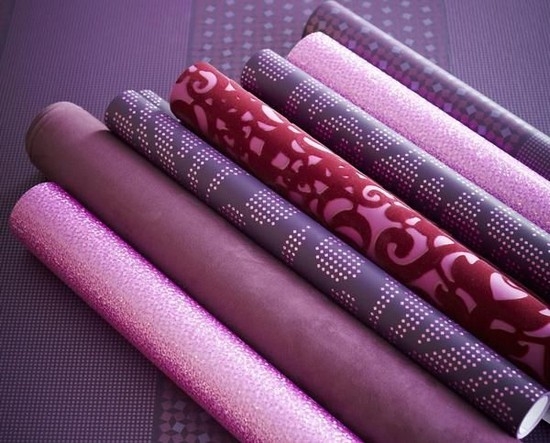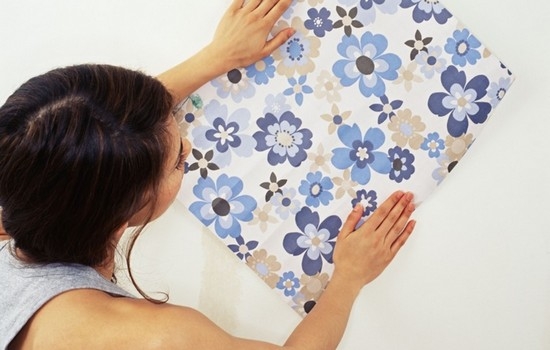Wallpaper manufacturers offer a variety of decorative options to suit every taste. Traditional vinyl and non-woven products are available in a single color or pattern, and can even be made with your own photo prints. Let's consider which wallpaper is better - vinyl or non-woven.
Studying non-woven wallpaper
Non-woven fabric is made from non-woven textile fabric consisting of cellulose fibers, which are held together using polymer materials and glue. Since the material is based on cellulose, non-woven fabric is more likely to be paper than textile fabric. Only this paper with improved qualities:
- it is more durable;
- wear-resistant;
- with increased fire resistance.
Wallpaper made from this material is mainly used for subsequent painting. A textured pattern is applied to the surface of non-woven wallpaper, which is obtained by intaglio printing with the highest quality of smoothness and color. After covering the walls with such wallpaper, the effect of decorative plastering is created, and if there is a matching pattern, a certain ornament can be obtained.
Wallpaper made of non-woven material can withstand several repaintings, which is very convenient, since it is easy to modify the interior of a room at minimal cost. For painting, it is best to use water-dispersed or acrylic paints.
Before pasting the walls, you should pay attention to the fact that non-woven fabric is a fairly transparent material. Through it, inhomogeneity of plastering can be seen, for example, after cosmetic repair of cracks, or coating of the drywall surface with putty. In such a situation, it is necessary either to make the surface of the walls a uniform color, or to apply several layers of paint.
Read also:
To attach the wallpaper to the work surface, a special thick glue is used that does not leave marks when dry. The glue is applied only to the wall. Wallpaper strips on the wall are placed end-to-end, which allows you to get a continuous smooth surface without visible transitions from strip to strip.
Thus, the pros and cons of non-woven wallpaper can be sorted as follows.
|
Advantages |
Flaws |
|
A strong and thick base allows you to hide wall imperfections, cracks and irregularities. |
The surface layer is susceptible to damage in the form of scratches or dents. |
|
Non-woven fabric allows the walls to breathe as it allows air to pass through well. |
Dust can accumulate on surfaces with a textured pattern, which is not very useful for allergy sufferers and asthmatics. This is perhaps the only harm from non-woven wallpaper. |
|
They have increased fire resistance. |
High price. |
|
Wallpaper is easily applied to the wall, and the strips are pasted dry. |
|
|
Easily cleaned from dirt using water or detergents. |
|
|
It is possible to paint the wallpaper, which allows you to update the interior at any time. |
|
|
They can be easily separated from the walls during the next renovation. |
Or is vinyl wallpaper better?

Vinyl wallpapers are named after the material from which they are made. Thanks to plastic polyvinyl chloride, manufacturers are able to give wallpaper a varied look. Thus, the following types of vinyl wallpaper are distinguished:
- Lightweight soft wallpaper with high relief made of vinyl foam.
- Wallpaper made by hot stamping and imitating the appearance of textiles. They are called silk-screen printing.
- Non-woven wallpaper with a smooth vinyl coating. They have cleaning properties and have different appearances to match tiles, cork, and stone.
- Covered with hard vinyl. The densest type of vinyl wallpaper with high wear resistance and moisture resistance. They have a varied appearance with imitation of building cladding materials, leather, and textiles.
All types of such wallpaper have two layers: one, as already mentioned, is a vinyl covering, the second is a base, which is either non-woven or paper.
Let's look at the pros and cons of vinyl wallpaper.
|
Advantages |
Flaws |
|
The widest possibilities for simulating a variety of materials and relief structures with a rich range of colors. |
Inferior to natural materials in terms of breathability. A room covered with such wallpaper is considered insufficiently environmentally friendly. |
|
They give the walls a voluminous appearance and increase sound insulation. |
When gluing, glue is applied both to the walls and to the wallpaper itself. When wet, they stretch slightly, and after drying they narrow, which does not have a very good effect on the quality of the joints, which can come apart. |
|
They mask small defects on the surface of walls well, which makes it possible to avoid leveling them and giving them a uniform color. |
At high temperatures, vinyl releases formaldehyde into the air. Compared to linoleum or synthetic carpeting, these emissions are extremely low and harmless as long as the room is properly ventilated. |
|
They are suitable for use in damp environments, such as the bathroom. |
|
|
Wallpaper is resistant to light. |
|
|
With sufficient density they remain light and elastic, easily adhering to the wall surface. |
Which wallpaper should you choose?

In order to determine which wallpaper is better - vinyl, non-woven or paper, you need to decide what criteria to evaluate. And then, after calculating all the pros and cons, make the final choice. We bring to your attention the following criteria for wallpaper of these types.
|
Criterion |
Paper wallpaper |
Non-woven wallpaper |
Vinyl wallpaper |
|
Environmental friendliness (natural materials, breathability) |
|||
|
The complexity of the process of gluing walls |
|||
|
Price |
|||
|
Color scheme and design |
|||
|
Water resistance, washable wallpaper |
|||
|
Resistance to sunlight |
|||
|
Possibility of painting |
|||
|
Wear resistance |
|||
|
Potential for contamination |